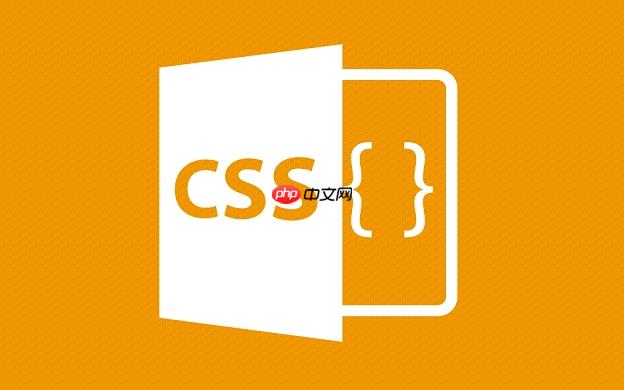使用position: sticky可实现表格滚动时固定列,需设置left/right偏移并确保父容器无overflow:hidden等限制,同时配合z-index和背景色避免显示异常。

在CSS中实现表格滚动时固定列,最直接且现代的方案通常是利用
position: sticky
<th>
<td>
left
right
overflow
要实现CSS表格滚动时固定列,我个人倾向于使用
position: sticky
首先,你需要一个包裹表格的容器,这个容器需要设置
overflow-x: auto
position: sticky
<th>
<td>
这是一个基本的HTML结构:
立即学习“前端免费学习笔记(深入)”;
<div class="table-container">
<table class="data-table">
<thead>
<tr>
<th class="fixed-column">姓名</th>
<th>年龄</th>
<th>城市</th>
<th>职业</th>
<th>薪资</th>
<th>入职日期</th>
<th>项目经验</th>
<th>技能栈</th>
<th>备注</th>
</tr>
</thead>
<tbody>
<tr>
<td class="fixed-column">张三</td>
<td>30</td>
<td>北京</td>
<td>软件工程师</td>
<td>20k</td>
<td>2020-01-15</td>
<td>电商平台</td>
<td>Java, SpringBoot</td>
<td>表现优秀</td>
</tr>
<tr>
<td class="fixed-column">李四</td>
<td>25</td>
<td>上海</td>
<td>前端开发</td>
<td>15k</td>
<td>2021-03-01</td>
<td>管理后台</td>
<td>Vue, React</td>
<td>学习能力强</td>
</tr>
<!-- 更多行 -->
</tbody>
</table>
</div>然后是CSS部分:
.table-container {
width: 100%;
overflow-x: auto; /* 允许水平滚动 */
white-space: nowrap; /* 防止内容换行,确保表格宽度超出容器 */
/* 可能还需要设置 max-height 和 overflow-y: auto 来处理垂直滚动 */
max-height: 400px; /* 示例:限制容器高度,允许垂直滚动 */
overflow-y: auto;
}
.data-table {
width: 100%; /* 确保表格能撑满容器,但如果内容多,它会超出 */
border-collapse: collapse; /* 合并边框 */
min-width: 800px; /* 示例:确保表格总宽度足够大,产生滚动 */
}
.data-table th,
.data-table td {
border: 1px solid #ddd;
padding: 8px 12px;
text-align: left;
background-color: #fff; /* 确保固定列有背景色,覆盖下方内容 */
}
/* 固定列的核心样式 */
.data-table .fixed-column {
position: sticky;
left: 0; /* 固定在左侧 */
z-index: 2; /* 确保固定列在滚动内容之上 */
background-color: #f0f0f0; /* 示例:给固定列一个不同的背景色,更醒目 */
}
/* 如果表头也需要固定,可以单独处理 */
.data-table thead th {
position: sticky;
top: 0; /* 固定在顶部 */
z-index: 3; /* 表头应在固定列之上 */
background-color: #e0e0e0; /* 示例:表头背景色 */
}
/* 同时固定左侧列和表头左上角单元格 */
.data-table thead .fixed-column {
z-index: 4; /* 左上角单元格在所有固定元素之上 */
}这里我给出了一个相对完整的方案,包括了表头和第一列同时固定的情况。
z-index
background-color
position: sticky
在使用
position: sticky
overflow
position: sticky
overflow: hidden
overflow: scroll
overflow: auto
visible
sticky
sticky
overflow
overflow
sticky
left: 0
position: sticky
top
bottom
left
right
position: sticky
position: static
table
position: sticky
<th>
<td>
<tr>
<tbody>
transform
perspective
sticky
transform
filter
perspective
position: sticky
z-index
sticky
z-index
z-index
position: sticky
排查这些点,通常就能解决
position: sticky
overflow
transform
z-index
position: sticky
尽管
position: sticky
双表格(Two Tables)方法: 这是一个比较传统的方案,尤其在
position: sticky
<table>
overflow-x: auto
height
CSS Grid/Flexbox 结合 position: absolute
<table>
display: grid
display: flex
<table>
overflow-x: auto
display: flex
flex-shrink: 0; width: Xpx;
flex: 1; overflow-x: auto;
display: grid; grid-template-columns: Xpx 1fr;
<table>
<table>
<table>
position: absolute
JavaScript 库: 对于大型、复杂的数据表格,或者需要更多高级功能(如排序、过滤、分页等)的场景,使用成熟的JavaScript库可能是最明智的选择。
在我看来,选择哪种方案,很大程度上取决于你对“纯CSS”的追求程度,以及项目对浏览器兼容性的具体要求。对于大多数现代项目,
position: sticky
在桌面端固定表格列能带来很好的体验,但到了移动端,屏幕尺寸的限制让这种设计变得非常棘手。我发现,简单地将桌面端的固定列方案移植到移动端往往会导致糟糕的用户体验,所以响应式处理是必不可少的一环。
媒体查询(Media Queries)禁用固定列: 这是最直接也最常用的方法。在小屏幕上,我们通常会选择禁用固定列的效果,让表格完全水平滚动。
@media (max-width: 768px)
position: sticky
left/right
z-index
@media (max-width: 768px) {
.data-table .fixed-column,
.data-table thead th {
position: static; /* 禁用固定效果 */
left: auto;
right: auto;
z-index: auto;
background-color: #fff; /* 恢复默认背景 */
}
.table-container {
white-space: normal; /* 允许内容换行,但可能需要其他处理 */
}
.data-table {
min-width: unset; /* 移除最小宽度限制 */
}
}优先显示重要列,隐藏次要列: 在小屏幕上,用户对信息的获取效率要求更高。与其让他们滚动查看所有列,不如只显示最重要的几列。
display: none;
表格行转换为卡片(Card View): 这种方案彻底改变了表格的呈现方式,将每一行数据转换为一个独立的“卡片”,更符合移动端单列滚动的习惯。
<table>
display
block
<tr>
display: block
<td>
display: block
::before
/* 示例:将表格转换为卡片视图 */
@media (max-width: 600px) {
.table-container {
overflow-x: hidden; /* 禁用水平滚动 */
}
.data-table,
.data-table thead,
.data-table tbody,
.data-table th,
.data-table td,
.data-table tr {
display: block;
}
.data-table thead tr {
position: absolute; /* 隐藏表头 */
top: -9999px;
left: -9999px;
}
.data-table tr {
border: 1px solid #ccc;
margin-bottom: 10px;
}
.data-table td {
border: none;
border-bottom: 1px solid #eee;
position: relative;
padding-left: 50%; /* 为伪元素留出空间 */
text-align: right;
}
.data-table td::before {
content: attr(data-label); /* 使用data-label属性显示表头 */
position: absolute;
left: 6px;
width: 45%;
padding-right: 10px;
white-space: nowrap;
text-align: left;
font-weight: bold;
}
/* HTML中需要给td添加data-label属性,例如:<td data-label="姓名">张三</td> */
}清晰的滚动提示: 如果最终还是选择让表格在小屏幕上水平滚动,那么一定要给用户一个明确的视觉提示,告诉他们表格是可以滚动的。
box-shadow
linear-gradient
在我的经验里,没有一劳永逸的响应式方案,往往需要根据表格数据的特性和用户群体来综合选择。对于数据量大、列数多的表格,卡片视图通常是最好的选择。而对于列数不多的简单表格,禁用固定列并允许水平滚动,辅以滚动提示,也足够了。关键在于,不要让用户在小屏幕上为了查看数据而感到沮丧。
以上就是CSS表格滚动固定列怎么实现_CSS表格滚动固定列实现步骤的详细内容,更多请关注php中文网其它相关文章!

每个人都需要一台速度更快、更稳定的 PC。随着时间的推移,垃圾文件、旧注册表数据和不必要的后台进程会占用资源并降低性能。幸运的是,许多工具可以让 Windows 保持平稳运行。

Copyright 2014-2025 https://www.php.cn/ All Rights Reserved | php.cn | 湘ICP备2023035733号